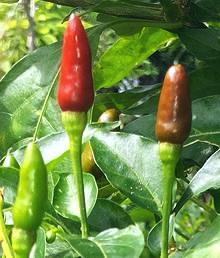
[C. annuum]
"Sili" is Filipino for Chili. In Filipino cuisine the chilis used are almost always either Sili Mahaba or Sili Labuyo, but there are complications. Here are described some named varieties with the best information I could gather on them. Filipinos are not very informative about their chilis and the naming used in Philippine markets here in Southern California is equally uninformative. Photo by Ringer (cropped) distributed under license Creative Commons Attribution-ShareAlike 4.0 International.
More on Chili Peppers.
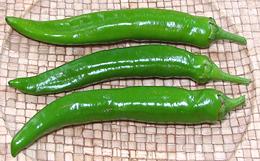 [Finger Pepper,
Siling Pangsigang (lit. chili for Sinigang), Siling Haba, Siling Espada,
Chili Picante, Long Pepper, Spanish Pepper; Capsicum annuum
var. longum]
[Finger Pepper,
Siling Pangsigang (lit. chili for Sinigang), Siling Haba, Siling Espada,
Chili Picante, Long Pepper, Spanish Pepper; Capsicum annuum
var. longum]
A long yellowish green chili, 4 to 6 inches long, about 3/4 inch diameter at the stem end, and tapering to a point. Pinning down how hot Mahabas are has not been easy, as information from the Philippines is conflicting. I now have pretty reliable evidence that Mahabas are "mild to medium mild", which has allowed me to assign "Mahaba" to these chilis. They have just started to appear in quantity in a Philippine market near me (Eagle Rock, California), sold as "Chili Sweet" for 2015 US $2.99 / pound.
These chilis ranged between 4-1/2 and 5-1/2 inches
long and 3/4 inch at the cap end. They varied in heat from almost no heat
(a few) to distinctly sharp (most). The walls are fairly thin, and note
the slight swelling just below the cap, which appears in most photos
I've found of Mahabas.
Subst: Korean chilis sold here in Los Angeles are a
little hotter and a little longer, but will serve in most recipes. If
size is not an issue, the common Anaheims are probably good, though they
are a lot larger and have thicker walls. Otherwise use hotter chilis
such as Serranos or Indian and remove the seeds and veins.
To complicate things more, in 2007, the guy at Market Manila bought
some 9 inch chilis he was told were "just like Mahabas, just bigger and
greener", but they turned out to be blazing hot. Those are, to the best
of my knowledge, as yet unidentified.
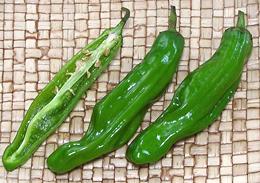 [Japanese Chile; C. annuum]
[Japanese Chile; C. annuum]
The Philippine markets here in Los Angeles often have piles of these
to use as a substitute for Sili Mahaba, which are still very scarce
around here. Fresh dark green (red ones are very rare), these chilis
have unique lengthwise ridges and blunt ends. They have good flavor
are generally very mild at H0, but about 1 in
20 can surprise, cranking it up into H1 range.
Like other California produce, they are tending to get larger (easier
to harvest). For my earlier photo the largest was 3 inches long and 1/2
inch diameter. A recent purchase (Oct 2017) was up to 4-3/4 inches
long and 7/8 inch diameter, but still very mild. For details see our
Shishito Chilis page.
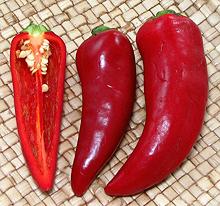 ["Red Jalapeno" (some U.S. supermarkets); C. annuum]
["Red Jalapeno" (some U.S. supermarkets); C. annuum]
Many Philippine recipes call for "Red Finger Chili" or "Long Red Chili".
These would be the red ripe Sili Mahaba, impossible to find in North
America, even in Los Angeles. While we grow a dozen green chili varieties
here, so many of our ethnicities have accepted the Red Fresno for their
cuisines, the only fresh red chilis much available here are the Red Ripe
Fresno and the Red Thai Chili. Their hotness is about
H4-5, but they are easily disarmed
by removing seed core and membranes. If shape is an issue, you'll have to
track down Holland Reds, sometimes sold in the big chain supermarkets.
Fresnos are most reliably found in Asian markets, particularly Korean
and Southeast Asian. For details see our
Fresno Chilis page.
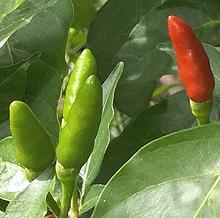 [lit. "Wild Chili"; C. frutescens]
[lit. "Wild Chili"; C. frutescens]
The standard really, really hot pepper of the Philippines, small,
somewhat blunt on the end, extremely hot, about
(H9) and may be red, yellow or
white when ripe. They were once listed as the world's hottest
chilis, but have long been displaced with much hotter chilis. They
are becoming scarce in the Philippines because growers find the
longer, pointier Thai chilis easier to grow and harvest, and sell
them as "Siling Labuyo", but some complain the flavor is different
and they are not as hot.
Subst: The obvious substitute is the widely
available Thai chili, since that is displacing Siling Labuyo in
the Philippines. They are somewhat milder (so use more), thinner, and
quite a bit longer and more pointy. A local Asian grower may have short
hot bird peppers more similar to Labuyos.
Photo by Ringer (cropped) distributed under license Creative
Commons
Attribution-ShareAlike 4.0 International.
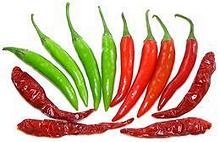
[Prik Ki Nu (Thai); Mak Pet Ki Nuu (Laos); Scuds (some chefs); C. annuum]
This chili has been supplanting the real Siling Labuyo in the Philippines
because it is easier to grow and harvest. It is often sold as "Siling
Labuyo", but Filipinos complain it isn't as hot as the real one and has
a different flavor. This chili is quite hot, about
(H8), slightly less hot when red
ripe, and a little less than that when dried. It is small, often less than
1-3/4 inches long as grown in Thailand, but there are many varieties and
those grown in California are often up to 2-3/4 inches (more efficient
to grow and harvest large sizes) and are often less hot than they should
be. They are narrow, pointy, and start growing point up, but turn
downward as they reach full size. They turn from green to red when ripe,
but there are bright orange varieties too.
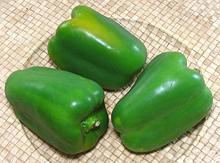
[Atsal, (Philippine); Rounded Pepper, Capsicum annuum var grossum]
Basically these are medium size Bell Peppers, same as ours, and
are generally used green. They may be used as a vegetable ingredient
or a shell for stuffing.
Subst: None required, we have plenty of green bell
peppers in North America, and even some medium size ones.
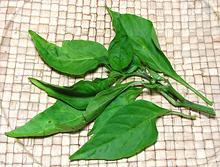 [Dahon ng Sili (Philippine)]
[Dahon ng Sili (Philippine)]
These are used in a number of recipes. In the Philippines they are
usually from Siling Labuyo, but what chili variety they come from is
not particularly important, as the leaves have no heat. Those I've
purchased in Southern California were from the chili I've now been able
to identify as Sili Mahaba. Chili leaves are also used in Thailand to
make green curry past greener.